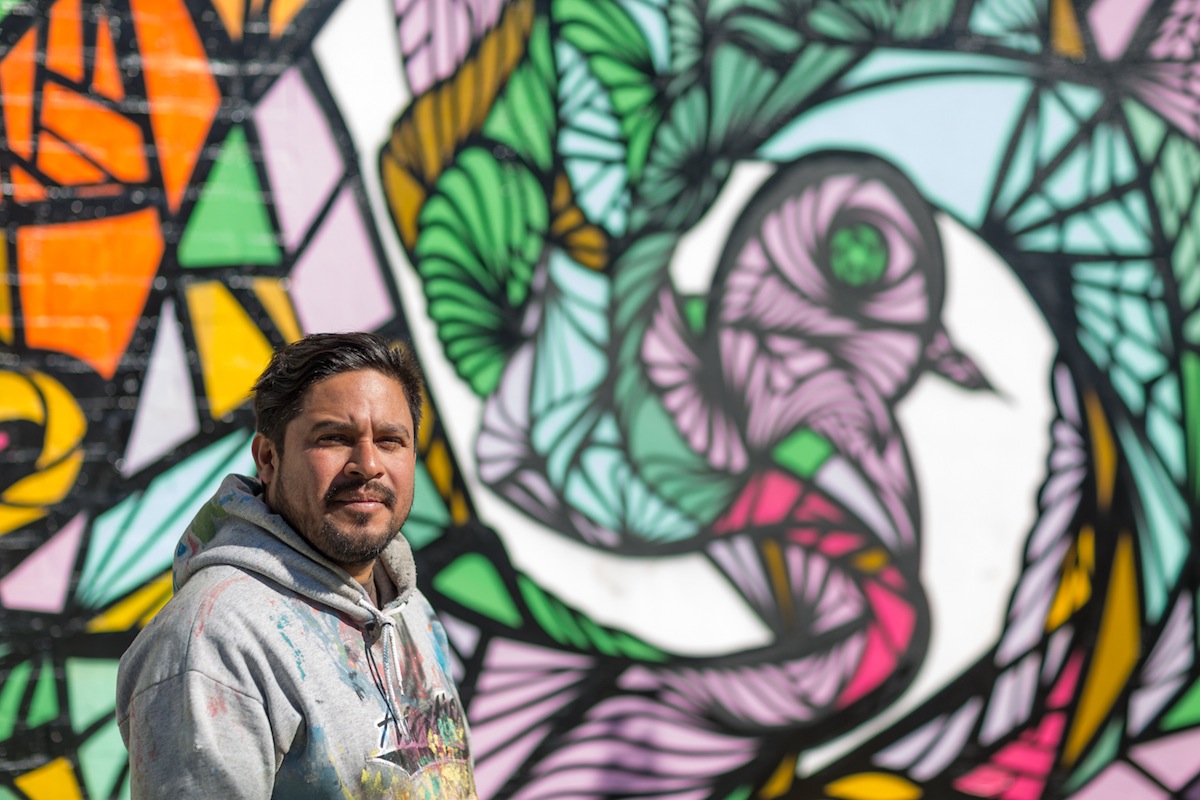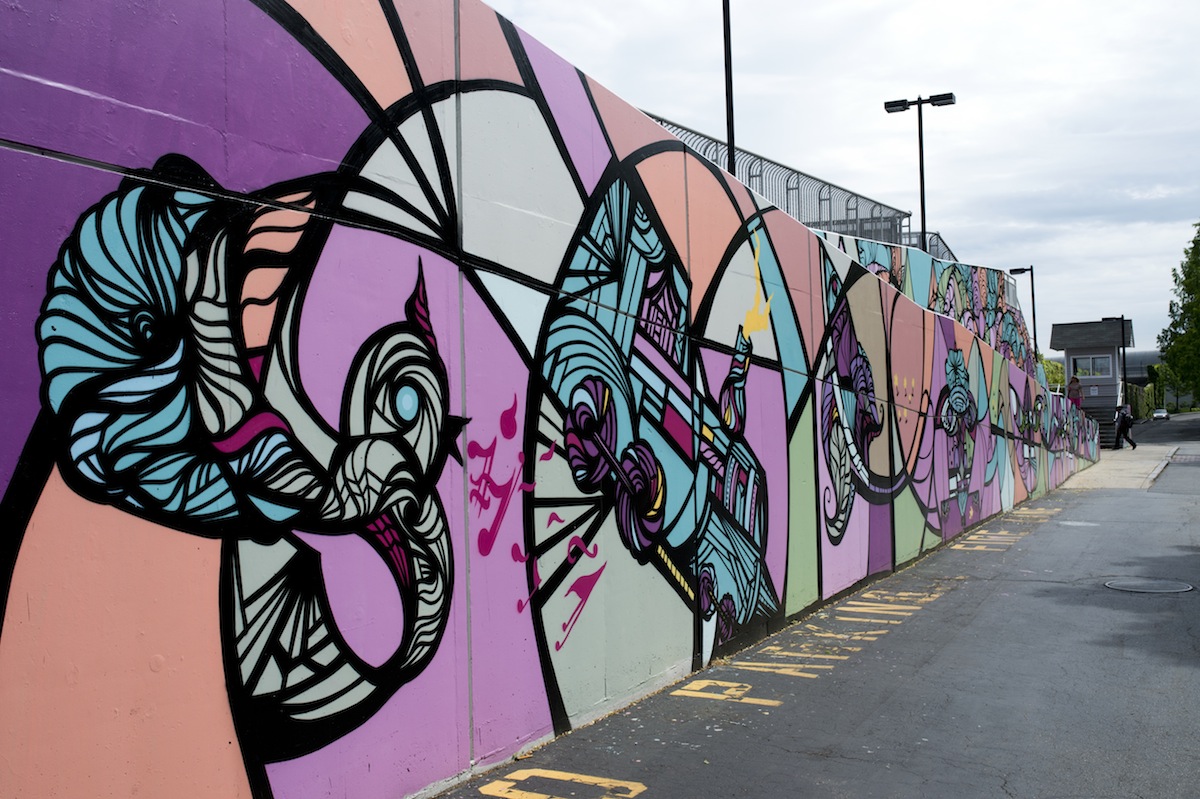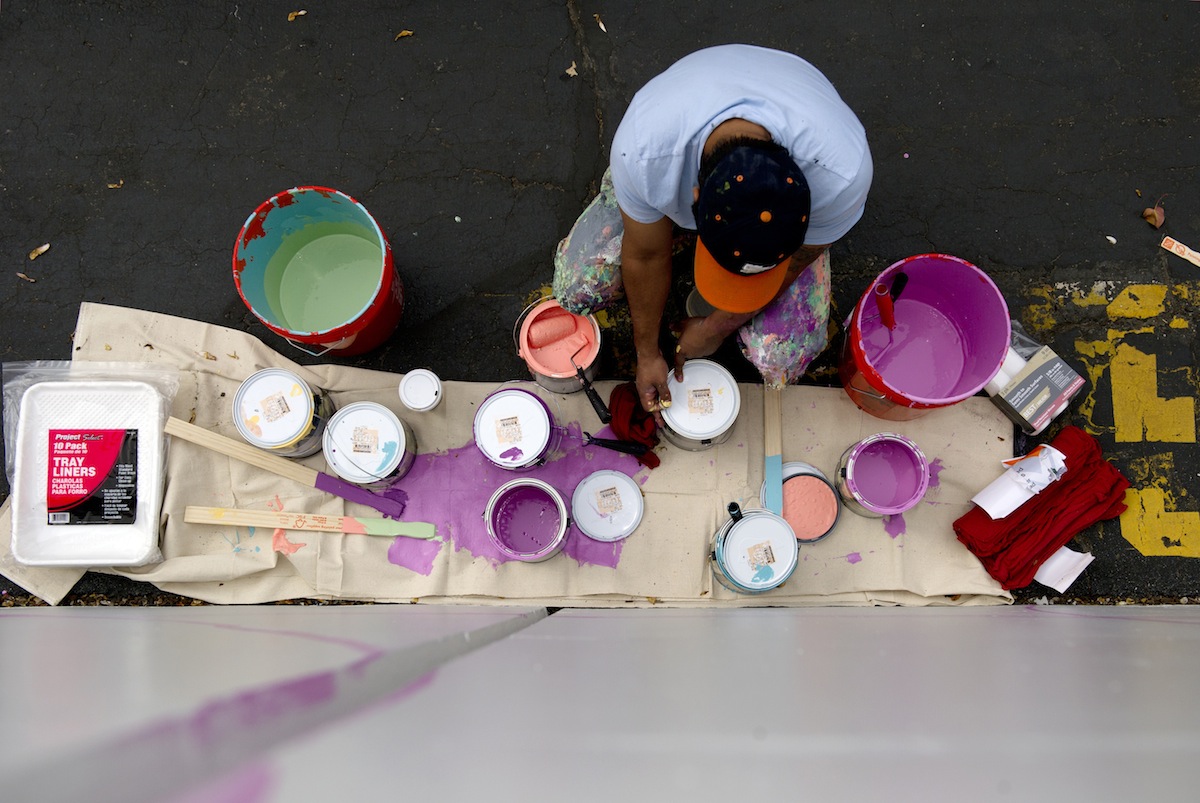Northeastern Takes On New Program to Bring Public Art to Campus Culture

Image courtesy of Alex Barber
These days, Northeastern University is welcoming back more than just students to campus. As part of a new “public arts initiative,” the school will be transforming portions of its buildings, walls, and interior and exterior open spaces into makeshift canvases for rotating art installations created by students, faculty, and artists from around the world.
To start off the new program, which will enrich the lives of people on campus as they come across commissioned works scattered throughout Northeastern’s property, the school recently hosted artist-in-residence Daniel Anguilu, a Houston-based muralist with a penchant for street paintings made of thick black lines and colorful swirls.
In May, Anguilu finished up a massive mural that’s plastered on the tri-level pedestrian bridge and retaining wall that leads to the MBTA’s Ruggles Station, located beside Northeastern’s Curry Student Center. When students return to Northeastern this month, many of them will see it for the first time, turning their drab walk to class into a more visually appealing experience.
“This was the first time I worked closely with a university,” said Anguilu, who was picked from a pool of 50 potential artists by a special committee formed by Northeastern President Joseph Aoun. “In an intellectual way, it was a different experience. I spent a lot of time standing there thinking about what colors to use, how to start the outline, and how it was going to interact with people because you are walking into the installation—you are walking into three levels of the painting.”
When he first came to campus at the end of the spring semester to begin the mural, a project completely funded by the school, he had an idea in his mind about what he wanted to paint. But shortly before he arrived to Boston for his weeklong stay, Anguilu said he felt moved and inspired by the death of one of his favorite authors, Gabriel Garcia Marquez, who wrote One Hundred Years of Solitude.
“Most artists will have everything drafted and good to go. I asked for complete freedom, and I asked to come in and have them allow me to paint. I just wanted to show up, and if something came up along the way and I wanted to push the mural in that direction, I wanted to do that. And that was the case with this piece,” said Anguilu.
In keeping Garcia Marquez in mind, Anguilu set out on his project, incorporating a subtle dedication to the novelist’s life into the pattern on the bridge, a mixture of rhythmic strokes using acrylic house paint and spray paint to create veiny-looking lines like those on a leaf.
Anguilu said he picked a particular pallet of bursting colors—oranges, turquoise, and pops of purple—to compliment the “coolness” of area, which features a flower garden, a stream, sculptures, and a grassy section where people can sit and contemplate the painting.
“There’s a level of tranquility in the area, and a lot happening in that area; a sense of calmness,” he said. “I enjoyed just sitting there and watching people, and I wanted something to become part of it once you’re in there and look at everything surrounding you. Most people there know who [Garcia Marquez] is, but it was also an introduction to the author for some people, and it was nice to have something that’s not just visually appealing, but also something they can research and learn to understand.”

Image via Brooks Canaday
Anguilu’s mixture of art and educational opportunity opened the doors for Northeastern’s newest program. As the school year begins, students and faculty—and even the general public, in some instances—won’t only be met by Anguilu’s tribute to Garcia Marquez, but also a host of other original works by a spectrum of talent.
“Northeastern University is bringing in artists from around the world whose inspiring work will promise to transform campus,” a representative from the school wrote in an email to Boston.
Beginning September 1, the school will tap into its own art scene as part of the “Project Art Lift” program, which will take the works of students, alumni, and faculty to turn six of the campus elevators in mini-murals covering the doors and walls both inside and out.
In October, Northeastern will continue the artist-in-residence program and host artist Tatyana Fazlalizadeh, an African-American and Iranian activist who will bring her “Stop Telling Women to Smile” public art series to Boston to address gender-based street harassment.
For three days, Fazlalizadeh will extend her project from the confines of Northeastern’s borders, and lead students and young people on a wheat-pasting expedition through the city, examining how women are harassed and how activism can be visualized through artistic mediums. The artist-in-residence will conclude her stay at the school by sitting on a special panel alongside other experts to discuss Title IX and the Clery Act, and how college campuses can be made safe and welcoming for women.
The school hopes that as they welcome more outside artists to their campus, they share a similar experience like that of Anguilu, taking in Northeastern’s surroundings, while adding to its environment.
“I had a really good time, and most of my energy comes through public art, so I’m happy when new projects come about and have a future,” said Anguilu. “The project was very important to me. I think empty spaces should be used for art pieces, especially on a large scale—it becomes part of the environment, and sometimes people begin to understand it and it lives with them. It’s important.”

Image via Mariah Tauger


